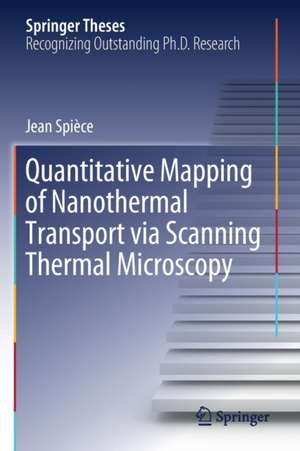Quantitative Mapping of Nanothermal Transport via Scanning Thermal Microscopy: Springer Theses
Autor Jean Spièceen Limba Engleză Paperback – 30 oct 2020
| Toate formatele și edițiile | Preț | Express |
|---|---|---|
| Paperback (1) | 634.49 lei 6-8 săpt. | |
| Springer International Publishing – 30 oct 2020 | 634.49 lei 6-8 săpt. | |
| Hardback (1) | 640.71 lei 6-8 săpt. | |
| Springer International Publishing – 30 oct 2019 | 640.71 lei 6-8 săpt. |
Din seria Springer Theses
- 18%
 Preț: 997.88 lei
Preț: 997.88 lei -
 Preț: 389.88 lei
Preț: 389.88 lei - 15%
 Preț: 646.94 lei
Preț: 646.94 lei - 18%
 Preț: 943.43 lei
Preț: 943.43 lei -
 Preț: 399.29 lei
Preț: 399.29 lei - 18%
 Preț: 944.99 lei
Preț: 944.99 lei - 15%
 Preț: 636.80 lei
Preț: 636.80 lei - 18%
 Preț: 941.05 lei
Preț: 941.05 lei - 15%
 Preț: 643.16 lei
Preț: 643.16 lei - 15%
 Preț: 642.68 lei
Preț: 642.68 lei - 18%
 Preț: 1103.62 lei
Preț: 1103.62 lei - 20%
 Preț: 558.83 lei
Preț: 558.83 lei - 18%
 Preț: 1112.30 lei
Preț: 1112.30 lei - 18%
 Preț: 944.19 lei
Preț: 944.19 lei - 18%
 Preț: 1109.92 lei
Preț: 1109.92 lei - 18%
 Preț: 1217.27 lei
Preț: 1217.27 lei - 15%
 Preț: 640.06 lei
Preț: 640.06 lei - 15%
 Preț: 636.45 lei
Preț: 636.45 lei - 15%
 Preț: 640.06 lei
Preț: 640.06 lei - 15%
 Preț: 640.88 lei
Preț: 640.88 lei -
 Preț: 389.70 lei
Preț: 389.70 lei - 20%
 Preț: 563.91 lei
Preț: 563.91 lei -
 Preț: 393.35 lei
Preț: 393.35 lei - 15%
 Preț: 637.93 lei
Preț: 637.93 lei - 15%
 Preț: 641.85 lei
Preț: 641.85 lei - 18%
 Preț: 1225.94 lei
Preț: 1225.94 lei - 20%
 Preț: 551.36 lei
Preț: 551.36 lei - 18%
 Preț: 1229.10 lei
Preț: 1229.10 lei - 15%
 Preț: 639.25 lei
Preț: 639.25 lei - 18%
 Preț: 999.45 lei
Preț: 999.45 lei - 15%
 Preț: 640.06 lei
Preț: 640.06 lei - 18%
 Preț: 1220.45 lei
Preț: 1220.45 lei - 18%
 Preț: 1116.26 lei
Preț: 1116.26 lei - 18%
 Preț: 1110.72 lei
Preț: 1110.72 lei - 18%
 Preț: 1000.87 lei
Preț: 1000.87 lei - 18%
 Preț: 891.17 lei
Preț: 891.17 lei - 15%
 Preț: 640.06 lei
Preț: 640.06 lei - 5%
 Preț: 1154.07 lei
Preț: 1154.07 lei - 15%
 Preț: 635.96 lei
Preț: 635.96 lei - 15%
 Preț: 640.88 lei
Preț: 640.88 lei -
 Preț: 387.20 lei
Preț: 387.20 lei - 18%
 Preț: 1109.92 lei
Preț: 1109.92 lei -
 Preț: 385.25 lei
Preț: 385.25 lei -
 Preț: 385.25 lei
Preț: 385.25 lei - 18%
 Preț: 1112.30 lei
Preț: 1112.30 lei - 18%
 Preț: 999.45 lei
Preț: 999.45 lei -
 Preț: 386.99 lei
Preț: 386.99 lei - 15%
 Preț: 637.13 lei
Preț: 637.13 lei - 20%
 Preț: 554.21 lei
Preț: 554.21 lei - 20%
 Preț: 555.59 lei
Preț: 555.59 lei
Preț: 634.49 lei
Preț vechi: 746.47 lei
-15% Nou
Puncte Express: 952
Preț estimativ în valută:
121.41€ • 129.83$ • 101.23£
121.41€ • 129.83$ • 101.23£
Carte tipărită la comandă
Livrare economică 18 aprilie-02 mai
Preluare comenzi: 021 569.72.76
Specificații
ISBN-13: 9783030308155
ISBN-10: 3030308154
Pagini: 153
Ilustrații: XIX, 153 p. 95 illus., 76 illus. in color.
Dimensiuni: 155 x 235 mm
Greutate: 0.25 kg
Ediția:1st ed. 2019
Editura: Springer International Publishing
Colecția Springer
Seria Springer Theses
Locul publicării:Cham, Switzerland
ISBN-10: 3030308154
Pagini: 153
Ilustrații: XIX, 153 p. 95 illus., 76 illus. in color.
Dimensiuni: 155 x 235 mm
Greutate: 0.25 kg
Ediția:1st ed. 2019
Editura: Springer International Publishing
Colecția Springer
Seria Springer Theses
Locul publicării:Cham, Switzerland
Cuprins
Outline and motivations.- Background Review.- SThM Experimental Models and Setups for Exploring Nanoscale Heat Transport.- Quantitative Thermal Transport Measurements in Nanostructures.- Three Dimensional Mapping of Thermal Properties.- Nanoscale Thermal Transport in Low Dimensional Materials.- Thermoelectric Phenomena in Graphene Constrictions.- Conclusion and Perspectives.- Appendices.
Notă biografică
After graduating from the Université Libre de Bruxelles in both Ethics and Physics, Jean Spièce was one of the research brains in the major European project 'Quantiheat' through which he obtained his PhD at Lancaster University. The aim of this European project was to tackle the challenge of quantitative nanoscale thermal transport measurements. Beyond this topic, Jean Spièce's research interests are primarily materials nanoscale properties with a focus on thermal and thermoelectrical scanning probe microscopy applications. After finishing at Lancaster University, he took a position in the consulting industry where he strives to find impactful solutions for innovative partners.
Textul de pe ultima copertă
The thesis tackles one of the most difficult problems of modern nanoscale science and technology - exploring what governs thermal phenomena at the nanoscale, how to measure the temperatures in devices just a few atoms across, and how to manage heat transport on these length scales. Nanoscale heat generated in microprocessor components of only a few tens of nanometres across cannot be effectively fed away, thus stalling the famous Moore's law of increasing computer speed, valid now for more than a decade. In this thesis, Jean Spièce develops a novel comprehensive experimental and analytical framework for high precision measurement of heat flows at the nanoscale using advanced scanning thermal microscopy (SThM) operating in ambient and vacuum environment, and reports the world’s first operation of cryogenic SThM. He applies the methodology described in the thesis to novel carbon-nanotube-based effective heat conductors, uncovers new phenomena of thermal transport in two- dimensional (2D) materials such as graphene and boron nitride, thereby discovering an entirely new paradigm of thermoelectric cooling and energy production using geometrical modification of 2D materials.
Caracteristici
Nominated as an outstanding Ph.D. thesis by the Lancaster University, Lancaster, England Includes multiple images and diagrams helping to understand and visualize the research Presents a unique approach of Scanning Thermal Microscopy to study thermoelectric properties of 2D materials Offers an analytical framework backed up with experimental data, enabling quantitative nanoscale thermal transport measurements
